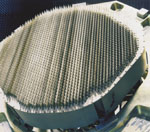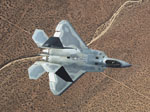Phased Array System Opens New Horizons
 |
| A multi-company research effort has converted an AN/APG-77 active electronically scanned array (AESA) radar into a communications system. While maintaining the radar’s sensor capabilities, engineers installed a software programmable modem that enables the device to transmit large data packages in seconds. |
An experimental technology soon may allow U.S. Air Force F-22 Raptor pilots to use the fighter’s radar as a high-bandwidth communications system. This capability would enable F-22s and other platforms to transmit in near real time imagery and other files too large for rapid dissemination by current datalinks. The application could greatly enhance the U.S. Defense Department’s network-centric warfare capabilities by turning tactical aircraft into reconnaissance and surveillance platforms.
The communications device was developed as part of a company-funded research initiative launched by three aerospace contractors involved in various aspects of the F-22 program: Lockheed Martin Corporation, Bethesda, Maryland; Northrop Grumman Corporation, Los Angeles; and L-3 Communications in New York City. The work focused on using the F-22’s AN/APG-77 active electronically scanned array (AESA) radar for high-capacity communications, something that has never been attempted before with a radar system, insist the three firm’s officials.
According to Kevin Smith, deputy director, F-22 improvements and derivatives, Lockheed Martin Aeronautics,
In late 2004, Lockheed Martin approached L-3 Communications and Northrop Grumman to discuss the possibility of using an airborne radar as a communications system. During the first technical meeting, the participants agreed that the concept was sound and executable, which launched the first phase of the demonstration, Smith notes. “First and foremost we had to ask the basic question, ‘Is it doable?’” he says.
The firms shared information to gain a better understanding of the concept’s inherent challenges from each other’s perspective then independently simulated the system based on predetermined operational parameters. “In general terms, we tried to prepare ourselves as much as we could prior to getting together at the Northrop Grumman site in
Because the team did its work in advance, it soon was able to demonstrate desired capabilities and quickly began to push the technology to determine the limits of the equipment and their knowledge. Smith observes that this experience allowed the multi-company team to prove the concept.
The technology demonstrator features a Northrop Grumman-manufactured AN/APG-77 AESA radar system and a 274-megabit-per-second common datalink modem emulator to send and receive high-bandwidth communications. The prototype system provided line-of-sight connectivity for both air-to-air and air-to-ground applications and successfully demonstrated communications at two to four times the modem’s speed of 274 megabits per second. The team also developed a hardware card that was interfaced into the radar and wrote new software code for the system.
High-capacity, software-programmable modems are a key enabling technology behind the AESA’s communications channels, explains Steve Barham, L-3 Communications’ director of programs for the Western Communication Systems division in Salt Lake City. L-3 leveraged its years of development experience with these types of modems to quickly adapt a waveform to the AESA’s characteristics. “The real question was, Can you use the AESA, which was designed to totally different specifications for radar purposes, and how well do those characteristics work for communication? We really didn’t know until we married those two technologies in the lab. When we did the demonstration, we found that they worked very well, and that has added to the enthusiasm,” he says.
It was important to modify the radar’s waveform to operate at shorter cycles to carry the communications waveform, says Joseph Ensor, vice president for combat avionics, Northrop Grumman Electronic Systems, Baltimore. He explains that Northrop Grumman engineers worked with L-3 to develop a waveform capable of transmitting data via the AESA but notes that when they inserted the communications application, the team was careful to avoid degrading the radar system’s primary mission capabilities.
Testing for the phased array system was restricted to Northrop Grumman’s
 |
| The AESA effort may allow fifth-generation fighters such as the F-22 Raptor to operate as unconventional reconnaissance and surveillance platforms in future combat zones. |
Felix Marcet, Lockheed Martin’s radar common datalink program manager, F-22 improvements and derivatives, Palmdale, notes that an AESA-based communications system may be able to operate at double the rate of common datalinks. He believes this is a good operational range and that the risk-reduction process will achieve these levels. One of the team’s goals is to reach a sustained operational rate of 100 to 200 megabits per second, which enables rapid file transmission. When these requirements are met, the Air Force will determine whether the data rates meet its needs and direct the radar’s use in other applications, he says.
Modifying the radar for use as a sensor and communications device has created a multipurpose system, says Bruce Carmichael, L-3’s vice president for programs, Western Communication Systems division. He adds that he views the AESA system as a melding of technologies for use in this application.
Smith says that such an all-in-one device would be useful for future capabilities because platforms such as the F-22 are potential nontraditional intelligence, surveillance and reconnaissance assets. He notes that coalition forces already are using F-15 fighters equipped with Litening targeting pods as reconnaissance platforms. As the Air Force begins using a variety of aircraft for surveillance missions, it will need the vehicles to provide real-time imagery. AESA technology makes this capability a reality by allowing an aircraft to transmit imagery from a variety of sensors such as forward-looking infrared systems, he explains.
Advanced tactical combat aircraft also may be able to collect and transmit other types of data. However, whether it is imagery or electronic intelligence information, these platforms will be linked to a larger, joint, network-centric sphere of operations, Marcet observes. “The number one goal is to help the warfighter in real time to do his mission faster, better, safer and more efficiently than ever before,” he says.
The AESA system’s transmissions are Internet protocol (IP)-enabled, making them compatible with other tactical datalinks. Barham expects the device to transmit IP packets from an F-22 at much higher data rates than the Joint Tactical Radio System’s waveforms. “From the beginning, we designed it to send IP packets. That allows the receiver node to put it into a router and disseminate the information over a wide variety of other paths. That’s the primary thing we are doing for interoperability,” he says.
The firms also believe that no one has yet attempted to develop and test a radar system as a communications device. Marcet notes that some groups have conducted feasibility studies, but he is not aware of any other organization or nation moving on to actual experimentation.
Discussions about the technology’s future are underway with the Air Force. Smith notes that the responses have been very positive and that senior Air Force officers are enthusiastic about AESA’s potential to support operations and to aid decision makers confronted with time-sensitive targets. “Think about the number of fifth-generation fighters in the battlespace. The ability to get information off of them, large data-type information—that hasn’t been perceived of before,” he maintains.
The radar’s development effort is now in its risk-reduction phase. The next opportunity for decision makers to select the technology officially will be in the fiscal year 2010 program objective memorandum (POM). Smith notes that the program missed the fiscal year 2008 process and that technical maturity issues still must be addressed. However, the team is working with the Air Force to arrange a flight demonstration in time to affect 2010 POM submissions.
Web Resources
Lockheed Martin: www.lockheedmartin.com
Northrop Grumman: www.northropgrumman.com
L-3 Communications: www.l-3com.com




Comments